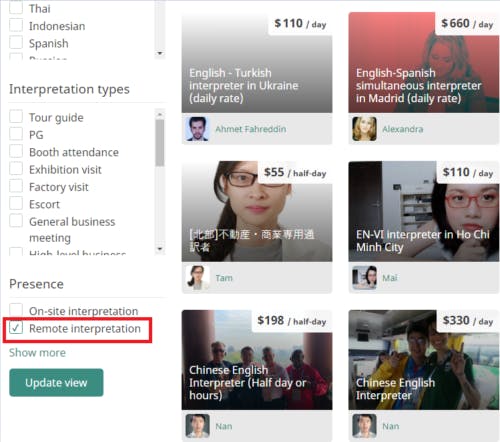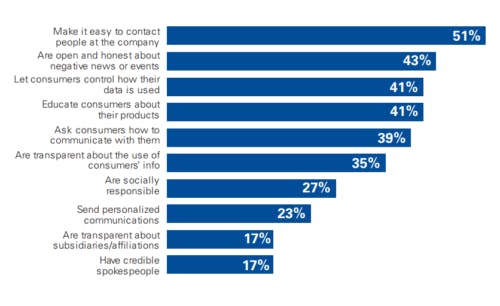How to introduce remote services to your marketplace
Freelensia co-founder shares the practical steps the marketplace took to move from on-site interpretation to remote services.
Published on
Last updated on

In this guest post, Freelensia co-founder Peter Nguyen explains how the team adapted to the Coronavirus pandemic by bringing remote interpretation services to the platform.
As the COVID-19 pandemic is ravaging businesses around the world, online marketplaces offering human services are heavily affected by lower consumer spending and social-distancing measures. To combat the effects, marketplace operators can try to tweak the business model and platform to accommodate remote services.
Online marketplaces are gaining immense popularity. The ingenuity of these marketplaces lies in the fact that almost anybody can create an account, advertise their services, or even set their own prices and communicate directly with other users.
However, the new coronavirus (COVID-19) pandemic has created many difficulties for marketplace operators. Not only do consumers have less income to spend overall. On-site services such as babysitting and house-cleaning are also no longer possible as social-distancing measures are adopted in many countries around the world.

There are some tactics marketplaces can use to combat the slowing down of business. In this article, I discuss how Freelensia tackled this problem. As an online marketplace helping companies hire short-term interpreters and translators to interpret in seminars, exhibitions, and conferences, we rode the wave by moving interpretation services from on-site interpretation to remote interpretation. I'll share three tactics that may help other marketplace operators move their suppliers’ services online as well.
As a fundamental business principle, the purpose of any online marketplace must be to create value for its users. In other words, your marketplace must identify the user’s problems and offer services that resolve the problems better than conventional methods can.
If remote services are the answer, then as the intermediary between clients and suppliers, you must analyze the pros and cons of promoting this opportunity. In this case, tools like cost-benefit analysis can be employed to help you decide if remote services are worth promoting.
To be specific, when looking at the translation and interpretation industry, Freelensia noticed that the geographic barrier is one of the biggest obstacles from the perspectives of both the service providers and clients. Remote interpretation (through audio or video web-conferencing technologies) is a great solution for clients in rural areas, where there is a lack of qualified interpreters. It also offers benefits to clients in developed countries wishing to hire interpreters from developing countries to cut costs. Using remote interpretation also helps reduce travel and accommodation expenses for all parties involved. Preparation time for the interpretation event can be shortened significantly as well.
On the supplier side, remote interpretation is a good option for interpreters who want to reach out to a bigger pool of clients outside their region or country. It also gives providers access to higher-paying projects. Remote interpretation provides them with more work flexibility and convenience, as they can perform their job anywhere, any time.
However, remote interpretation also has its disadvantages. Clients generally do not favor remote interpretation because of the perceived business risks, technological complexities, and lack of face-to-face communication. The disadvantages were not significant enough to discourage us from moving to remote services but needed to be taken into account in the way we set up the offering.
As you can see, we were able to identify multiple problems on both sides of the marketplace that remote offering might solve and that existed even before the pandemic. A closer investigation into your user base may well help you find out pre-existing pain points or challenges related to the new normal that your marketplace is in a unique position to solve.
Next, we’ll look at the kinds of changes you may need to make to your business approach to support virtual offerings.
Once you’ve decided that your marketplace platform is going to offer remote services, several adjustments to your business approach may be needed.
You need to be able to clearly indicate the change and offer features to support the virtual service offering. So, first of all, your website might need a few smaller or bigger changes to help users succeed with the new offering. Second, there might also be a need to adjust your onboarding procedure.
Your current marketplace website design may not be ideal for featuring remote services. To start with, think about how to make the services more noticeable and easier for users to select. This is important to do for both user groups: providers and customers.
To be specific, consider having a separate category for remote services to clearly differentiate them from the conventional ones your marketplace has been providing. On Freelensia’s website, we added a field called Presence which allows the interpreters to notify their clients whether their prices are for on-site or remote interpretation. They do this by simply ticking the “On-site interpretation” or “Remote interpretation” checkboxes when they are creating their listings.
For the clients, we also customized Freelensia’s listings page with a “Remote interpretation” checkbox that customers can use to filter out the interpreters providing remote services.

This function has been reported to be helpful to our suppliers and customers. Without the checkboxes, both parties had to have additional discussions if either one prefers remote interpretation. Now, they can check the checkboxes from the beginning and easily find the type of service they're looking for.
Once an interpreter accepts the reservation from a client, they can discuss further details via the chat system on our platform. They then carry out the remote interpretation event on their own. We do provide different kinds of support for this, which I’ll cover in the next chapter. In general, this is an important thing marketplace operators should consider if they are featuring remote services. Do you provide a platform to conduct the service? If not, what can you do to tackle the difficulties your users might face when they execute the services themselves?
Another critical point to consider is a reliable online payment functionality. Cash payment makes no sense when doing remote services since the two parties are not likely to meet face-to-face during the whole process.
If you have previously relied on cash payments like Freelensia did, switching to online payments can be a complicated project. However, it does bring an additional layer of security and ease to your marketplace, which will increase the value your platform offers to users in the long run.
The second point relates to the small but significant change we made to Freelensia’s provider onboarding process. Since not every user notices the changes in our website design, we reach out to them to make sure they won’t miss it.
When we notice a provider didn’t tick the “Remote interpretation” checkbox, we ask them in the onboarding email if they also offer interpretation services remotely. We then guide them further to edit their listings or create new listings for remote services.
After implementing this onboarding step, we noticed to our surprise that about half of the providers that hadn't signed up for remote interpretation were, in fact, willing to offer their service remotely. So, if you're making a big change to your marketplace offering, spend some extra time making sure your providers are onboarded properly and aware of all the opportunities your platform offers.
However, a simple follow-up won't be enough to convince all users to switch to remote services. Next, let's look at what you can do to help users be more comfortable with the change.
It is one thing to make design changes to accommodate remote offerings. It’s quite another to convince providers who are used to offering their services live to make the switch.
After the adjustments above were made, a few strategies have helped us make remote service even more appealing to our clients and suppliers. First, we provide comprehensive information so users can feel confident in switching to remote services. Second, when they actually carry out remote services, we assist them along the way.
Building trust is crucial for any type of sharing economy, especially when it comes to virtual products or services.
The KPMG 2017 Global Online Consumer Report shows that in addition to sufficient communication and honesty, providing customers with adequate information about the offered products is an effective tool for gaining customers’ trust in an online setting. This means you should identify the aspects in your offered services that clients are most insecure about and find a way to discuss them in an honest and effective way.

If a service has traditionally been conducted on-site, both sides can be hesitant to conduct it remotely. Clients may be afraid of losing service quality or facing technological issues. Service providers may be afraid of losing their reputation if the assignment fails, or of non-payments from the client. Without addressing these feelings of unfamiliarity, you may not get far with your remote offering. Therefore, it is important to have a good information database providing comprehensive knowledge about remote services.
In our case, Freelensia is building a knowledge database and blog articles (such as this one) to offer lots of information. We explain what remote interpretation is, how to succeed with interpretation in a remote setting, and what are the benefits that each party can get.
Even more importantly, we also address the potential drawbacks and offer tips to mitigate the risks. As mentioned above, before adding remote services, you should investigate the disadvantages and risks customers might associate with remote services. Then, inform your users about the challenges, along with recommendations on how to execute a successful remote service. Being open and honest about the challenges and showing that they can be overcome is a great way to increase marketplace trust and help your users succeed.
In addition to blog posts, consider adding comprehensive content on remote services to Frequently Asked Questions or any other section where you explain how your marketplace works. Go through your user journey and try to anticipate the stages where concerns arise and make sure you have convincing answers to give.
Once you have your content written, promote it across your channels for an extended period of time. This is, of course, vital for spreading awareness of your new offering. Your users are also expecting to hear from you as they’re relying on you to help them succeed on your platform.
If remote services are relatively new on your marketplace, it is necessary to support the service providers when they’re adopting a new way of working. They may also need help reaching potential clients. Helping your providers succeed with their services increases customer satisfaction, leads to more successful transactions, and boosts loyalty on the side of providers.
In addition to providing educational content, you may want to take an extra step by offering to organize the remote service together with the clients for an extra fee. Your clients can find this solution favorable if they do not have sufficient time to learn all the relevant materials. Your help ensures the seamless service implementation they desire.
For example, Freelensia recommended specific remote interpreters to the clients in a special email campaign. In this campaign, we highlighted key attributes of remote interpretation in general and relevant competencies of those interpreters in particular. Naturally, the email contains optimized call-to-action buttons to allow the client to book those interpreters instantly.
When it comes to conducting the actual remote interpretation event, we offer to set up the online meeting for our client for an extra fee. Alternatively, we provide the parties with comprehensive step-by-step instructions to make sure the remote interpretation event occurs smoothly. The instructions include everything each party needs to prepare in terms of appliances, online platforms, and the time needed to get things ready. We also share our best tips on what they can do to minimize the potential drawbacks of remote interpretation.
If your marketplace was affected by the Coronavirus outbreak, switching to remote services can help you ride the wave. Making the switch, there are three things you should consider.
Firstly, you should analyze your users’ unmet needs towards remote services and decide whether it is worth serving those needs. Secondly, you should adjust the way you do your business to accommodate remote services. In particular, think about how to improve the user experience by customizing your website or the payment method. Finally, provide comprehensive and clear guidelines and resources to all stakeholders and be honest about the potential drawbacks.
When both sides of your marketplace feel you are doing your best to help them succeed with remote services, they are more confident in giving those services a try.
You can find a version of this article in many languages on Freelensia's blog.
You might also like...

Online marketplace design: the 5 principles of a great marketplace UX
Five key online marketplace design principles and tons of practical tips and examples. Courtesy of marketplace UX designer Fiona Burns.

Marketplace software: How to compare and choose the best solution
There are dozens of online marketplace software alternatives to choose from. Learn how to make the right choice for your marketplace idea.

The concierge marketplace model: how to match supply & demand
Boost your growth by manually matching your marketplace supply and demand. Mike Williams discusses the benefits of the concierge marketplace model.
Start your 14-day free trial
Create a marketplace today!
- Launch quickly, without coding
- Extend infinitely
- Scale to any size
No credit card required
